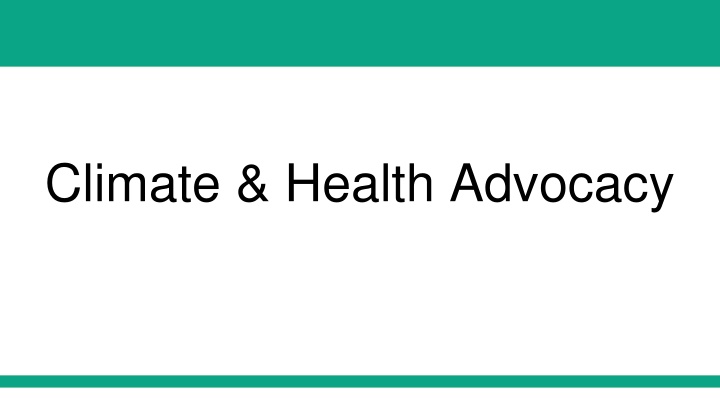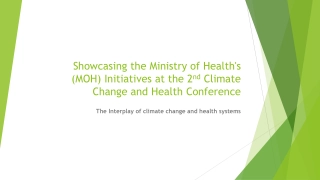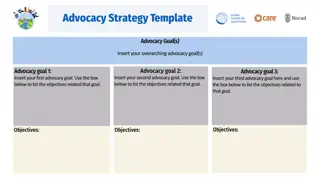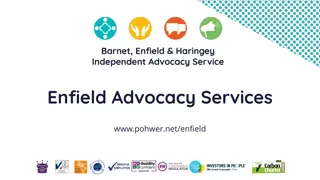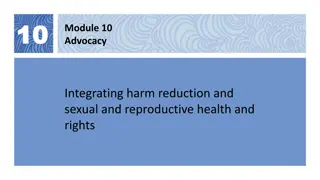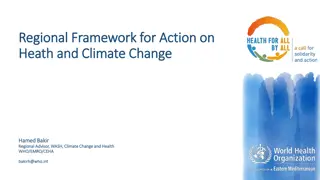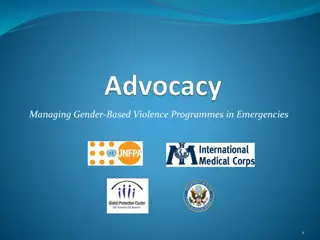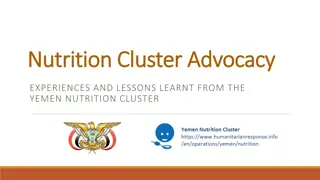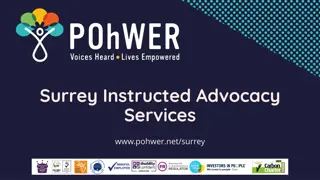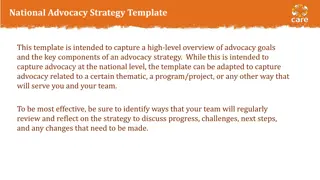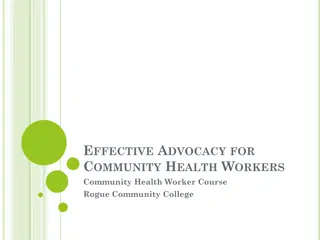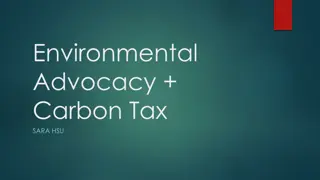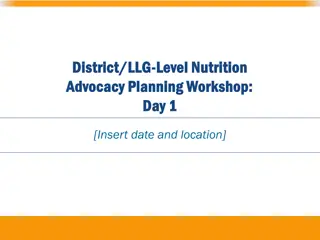Climate & Health Advocacy Strategy
This content discusses the advocacy agenda, priorities, and aims of the Faculty of Public Health's Climate & Health strategy. It highlights the importance of promoting health, addressing climate change, and advocating for environmental protection to ensure a better future for all. The strategy focuses on empowering the public health workforce, advocating for equality, and leading by example in becoming a net-zero organization.
Download Presentation

Please find below an Image/Link to download the presentation.
The content on the website is provided AS IS for your information and personal use only. It may not be sold, licensed, or shared on other websites without obtaining consent from the author.If you encounter any issues during the download, it is possible that the publisher has removed the file from their server.
You are allowed to download the files provided on this website for personal or commercial use, subject to the condition that they are used lawfully. All files are the property of their respective owners.
The content on the website is provided AS IS for your information and personal use only. It may not be sold, licensed, or shared on other websites without obtaining consent from the author.
E N D
Presentation Transcript
Ctrl & click on the links to go to the relevant section Structure of this slide-set 1. Background: FPH Climate & Health strategy: advocacy theme 2. Summary outputs from scoping work 3. Synthesis 4. More detailed slides on key papers
Ctrl & click arrow to return to summary slide Return with solid fill Structure of this slide-set 1. Background: FPH Climate & Health strategy: advocacy theme 2. Summary outputs from scoping work 3. Synthesis 4. More detailed slides on key papers
FPH climate & health strategys aims Our vision for climate and health Better health for all leaving no one behind, now and for future generations The Faculty of Public Health becomes a credible and respected voice on climate, environment and health impacts, and supports the public health workforce to lead on strategies to protect health and wellbeing for current and future generations. Our mission for climate and health As the professional membership body for public health, we will work to promote and protect health for everyone and will: -Ensure that the public health workforce has the knowledge, skills and capability to work on mitigation and adaptation to the climate emergency and environmental breakdown, including access to resources and the confidence to make the case for the health co-benefits of action on climate change -Advocate for inequalities to be essential to all work on climate, the environment and health, recognising that climate injustice creates health inequalities locally and globally -Demonstrate leadership by becoming a net-zero organisation
Strategys wording around advocacy Advocacy We will deliver an ambitious advocacy agenda with clear priorities and a strong evidence base to drive positive changes in addressing the climate, environment and health emergency at a global, national and local level Our priorities to 2025 Coordinate and collaborate with other organisations on key advocacy messages, at global, national and local levels, e.g. collaborate with others to proactively advocate on issues which are related to climate, environment and health Ensure that our members have the skills for advocating on climate change, environment, and health, specifically ensuring that they are able to advocate for those most affected by climate change and environmental breakdown, e.g. develop an "advocates" or "spokesperson" scheme for members to be able to advocate on key issues Develop a theory of change in order to inform our advocacy on climate change, the environment and health, e.g. workshops to develop our theory of change and consider how best to influence action in this field, ensuring that this includes a review of how to effectively advocate and learn from historical mistakes Prioritise advocacy where the outcomes will have the most impact such as high impact topic areas or where the opportunity to influence is greatest.
Summary of the Advocacy workstream Our aims are: To contribute to skills & support for members (who are better able to advocate and doing more advocacy as a result) A focus on inequalities Some success (tbc how measured) on proactive & reactive advocacy by the Faculty & the SIG We will start by: 1. Some scoping, reviewing & learning from others & the past 2. Develop focused proactive advocacy on a very small number of issues 3. Develop mechanisms (eg a group) for reactive advocacy 4. Skills programme & networks & other support for members & SIGs doing advocacy 5. Developing our Theory of Change for advocacy
Summary of scoping work We have completed a quick and dirty review to summarise the literature on advocacy. The purpose of this review was to inform the FPH s advocacy workstrand within the Climate & Health Strategy. The outputs of this review are: A reading list comprising the full set of papers that we included from our purposive search - this can be searched for in-depth information and added to over time. It is structured against the themes for the synthesis (see next slide) This slideset summary (see next slide) As a group, we can also help with providing more detailed input to the proactive advocacy & skills strands as requested (capacity permitting), for example presenting an overview of ingredients for success or suggesting tools or frameworks to use in planning campaigns.
Ctrl & click arrow to return to summary slide Return with solid fill Structure of this slide-set 1. Background: FPH Climate & Health strategy: advocacy theme 2. Summary outputs from scoping work 3. Synthesis 4. More detailed slides on key papers
Ctrl & click on the links to go to the relevant section Summary outputs from scoping work Each paper in the synthesis is annotated to show whether it is helpful for The scoping slide-set includes: A summary synthesis of key papers The case for advocacy Historical mistakes / lessons we need to learn from Ingredients for successful advocacy Types of advocacy Advocacy skills Things that are missing from the literature Key things you can find in the reading list Some tools and frameworks A slide per key paper - a bit more detail on the papers included in the synthesis Theory Tools Experience / evidence
Ctrl & click arrow to return to summary slide Return with solid fill Structure of this slide-set 1. Background: FPH Climate & Health strategy: advocacy theme 2. Summary outputs from scoping work 3. Synthesis 4. More detailed slides on key papers Throughout the synthesis, ctrl click on the underlined title or author text to get the link to the full papers Ctrl & click the arrows to get to the slides the key papers
Ctrl & click arrow to return to synthesis summary Return with solid fill Summary of findings: synthesis summary Theme heading The case for advocacy Historical lessons to learn from Ingredients for successful advocacy Short explanation of the evidence Snippet to whet your appetite Advocacy is effective in achieving improvements in population & planetary health Changes in social norms are critical for mitigation and often start with pilot experiments led by dedicated individuals and niche groups 11 commandments for Public Health Advocacy Analysis of what has and has not worked - from very strategic to very tactical Evidence it is possible to create and strengthen political commitment over time through concerted strategic action through 18 key factors including: effective networks, strong leadership, civil society mobilisation, supportive political administrations, societal change and focusing events, cohesive and resonant framing, robust data systems and available evidence. The ingredients include: Professional training Policy A focal point Identification of 18 factors that drive political commitment Campaigns using more strategies and involving more groups involved = more effective Tools based on experience & success for use Analysis of different types of advocacy and when they are most useful including theories, systems approaches, and ecosystems of social change Summarises the key skills Networks Framing Cross-party-political work A framework to analyse which advocacy theory suits your goals and then point to which advocacy strategies and tactics to use. advocacy often requires its practitioners to be unpopular vanguards. Types of advocacy Advocacy skills Content knowledge in three key areas: organisational and behavioural change, communications, and social movement theory theories of social change critical analysis strategic framing understanding the underlying tussle for values, winning the definition, importance of resonant communication the ability to collaborate with a diverse set of stakeholders on complex problems Helpful tools and toolkits on advocacy in general and some communications specific work on climate & justice
Ctrl & click arrow to return to synthesis summary Return with solid fill Summary of findings: case for advocacy IPCC WG3 report Demonstrates level of certainty in evidence for demand-side mitigation and the role of different forms of advocacy in achieving this including: collective action underpins system change, changes in social norms are critical for mitigation and often start with pilot experiments led by dedicated individuals and niche groups, middle actors are important and under-used Cursor with solid fill See also: Review on UN Nutrition Decade (in ingredients for success summary) which demonstrates possibility of creating and strengthening political commitment Casebook for advocacy (in skills for advocacy section) which makes the case for the importance of advocacy in public health Chapman on public health advocacy (in skills for advocacy section) which discusses some of the evidence for advocacy in public health
Ctrl & click arrow to return to synthesis summary Return with solid fill Summary of findings: historical mistakes / lessons Three decades why haven t we bent the emissions curve? Analyses historical reasons for not reducing emissions across multiple lenses, common thread is the role of power, identifies lessons including: importance of challenging entrenched power and mindsets, changing norms and institutions that are reproducing problems driving climate change, need for greater breadth of thinking, focus on equity, high-carbon lifestyles and conditions for enabling new social imaginaries to disrupt status quo Cursor with solid fill 11 commandments for PH advocacy reflections from Mike Daube who has played a big role in critical public health campaigns in Australia and internationally over more than four decades. Useful to read in more depth to learn from past when developing campaigns. 11 commandments are: act on sound evidence for action, be professional, develop comprehensive approaches and consensus positions and work in coalitions, clear messages, understand government, policy, politics, politicians, bureaucracy, be non-partisan, understand and work with the media, be innovative, don t be satisfied with soft options, be impatient but patient, oppose and expose the opposition. Cursor with solid fill
Ctrl & click arrow to return to synthesis summary Return with solid fill Summary of findings: ingredients for success (1) Health professionals are motivated to act/educate on climate and ecological emergency. Barriers = time constraints, lack of knowledge, feeling they won t make a difference, too risky personally or professionally, concern about controversy. Action = professional education, communication training, patient education materials, policy statements, guidance Kotcher et al Cursor with solid fill Most effective message: EXPLAIN THE RISK - Explain the problem (e.g. negative impacts of air quality), THE SOLUTION- explain how solution will benefit health (e.g. clean energy better AQ), NORMATIVE APPEAL - explain that most people support the solution, and how many people are taking action to advocate for the solution. Kotcher et al Cursor with solid fill Establish an organizational home for climate and health work, provide training and resources, engage in climate advocacy as an organization, and network with other organizations Mendoza-Vasconez et al Cursor with solid fill Importance of communication skills and framing, working with allies, working will all political parties, working with political leaders Lysack et al Cursor with solid fill
Ctrl & click arrow to return to synthesis summary Return with solid fill Summary of findings: ingredients for success (2) Freudenberg et al Analyses 12 case studies of public health advocacy and identifies lessons including more effective campaigns used more advocacy strategies (5.3 versus 4.1) and involved more constituencies (6.3 versus 5.1) than less effective ones. Case studies include one on automobiles emissions. Cursor with solid fill Review on UN decade of Nutrition Useful for understanding what is needed to create and strengthen political commitment (and evidence this is possible to achieve over time through concerted strategic action). Identifies 18 factors that drive commitment, key commitment drivers across different contexts include effective networks, strong leadership, civil society mobilisation, supportive political administrations, societal change and focusing events, cohesive and resonant framing, robust data systems and available evidence. Also identifies context specific drivers and barriers (for LMIC and HIC) Cursor with solid fill Networks, advocacy and evidence in public health Analyses 2 case studies to highlight the importance of policy networks and advocacy Key ingredients for success include: regular engagement within diverse network, trust, clear research-informed proposals, ability to deal with disagreement through strategic trade-offs to keep focused, leadership (some advocacy groups functioning as knowledge brokers), a high degree of scientific consensus perceived and communicated externally, a supportive wider social and political context. Cursor with solid fill Chapman advocacy for public health a primer Presents 10 key questions for PH advocates to think through when developing a media based advocacy campaign, followed by a case study to illustrate. Also includes links to lots of helpful resources (some listed in the slide notes for the paper) Cursor with solid fill Future Advocacy recommends asking three key questions in order to design an effective advocacy strategy: what do we want? Who can give it to us? Why haven t they given it to us already? Cursor with solid fill
Ctrl & click arrow to return to synthesis summary Return with solid fill Summary of findings: types of advocacy Mapping the movement for climate change and health helpful in identifying the gaps and role that the FPH could play as part of a movement of organisations, focuses on climate and health movements in England, identifies different methodological approaches used, a gap for systems change focus and argues for shift to working as a cohesive ecosystem. Cursor with solid fill 10 Theories to Inform Advocacy Identifies and describes 10 theories, split between Global theories (theories that explain how policy change occurs more broadly), and Tactical theories (theories from various social science disciplines that apply to common advocacy tactics that are likely part of broader advocacy efforts or campaigns) and when these might be useful. Could contribute to analysis of which theories to use when planning a campaign. Cursor with solid fill Middle-Out Perspective analyses how people working between government (top) and individuals (bottom) act to promote broader societal changes from the middle-out (rather than the top-down or bottom-up), illustrates with two case studies and identifies that using a wide range of middle-out can broaden coalitions and that care needs to be taken as they are not neutral, recommends mapping Cursor with solid fill Hunter et al provides a detailed worked example of using complex systems thinking to achieve a public health goal. Their approach includes seven integrated tasks (mapping stakeholders, umbrella review, policy mapping, participatory systems modelling, use of discrete choice experiments to understand relative importance of different approaches to car dependency, deliberative democracy, collaborative implementation planned and delivered by multiple stakeholders) through which they expect to attain a systemic view of the car dependency issue, potential intervention approaches to reduce it, and a framework for integration of interventions through coordination of stakeholder actions. Cursor with solid fill Bill Moyer looked at different activist roles and their influence at different moments for social change. This can help define different types of advocacy within the project or movement. Cursor with solid fill
Ctrl & click arrow to return to synthesis summary Return with solid fill Summary of findings: advocacy skills Casebook on advocacy in public health (includes case studies), World Federation of Public Health Associations, establishes what is public health advocacy and emphasizes the importance of advocacy as an essential public health function by bringing together 18 cases of public health advocacy from different corners of the world. Aims to increase knowledge and capacity to develop and implement advocacy strategies and inspire development of curricula and other training to strengthen advocacy. Cursor with solid fill The Advocacy Toolkit, Public Health Advocacy Institute of Western Australia, explains advocacy, includes examples and case studies, tips to work with the media, and practical tools to help you and your organisation advocate on your issue, also goes through types of advocacy and components of an advocacy framework (see eg frameworks section on later slides) Cursor with solid fill Public health advocacy discussion paper, Alberta Health Services, makes the case for increased theoretical competency, particularly increased content knowledge in three key areas: organizational and behavioural change, communications, and social movement theory all areas typically not included in public health education curricula. Outlines the key attributes of public health advocacy, highlights and explore the main challenges to practicing public health advocacy, and identifies key skills required for public health advocacy including: theories of social change, critical analysis, strategic framing and the ability to collaborate with a diverse set of stakeholders on complex problems. Cursor with solid fill Advocacy in Public Health (Chapman) Discusses focal points for public health advocacy (different upstream factors identified), reflects on experience and uses case studies to illustrate, identifies importance of media (different types) as main source of information for public, identifies and reflects (through case studies) on 3 key debates (when is regulation justified, what methods are justified, what is the evidence advocacy works). Suggests 4 important public health skills / attributes as: 1) understanding the underlying tussle for values, 2) winning the definition, 3) importance of resonant communication, 4) advocacy often requires its practitioners to be unpopular vanguards. Cursor with solid fill Fairness in UK climate advocacy messaging (Climate Outreach) this report recommends testing campaign messages with different groups in order to understand how they are perceived, to unpick how different policies will affect different income levels, and to ground messages in the idea that the least well off should pay less when it comes to climate policies. Cursor with solid fill
Ctrl & click arrow to return to synthesis summary Return with solid fill Summary of findings: things missing Lack of indigenous and local knowledge in the academic literature on transformation means missing important perspectives (https://www.ecologyandsociety.org/vol25/iss1/art3/) Need to: build appropriate psychological support into behavior change interventions, work with groups who can provide each other with emotional peer support, and ensure health and social care professionals are given adequate training.Frontiers | Relationships Between Climate Mitigation Actions and Mental Health: A Systematic Review of the Research Landscape | Climate (frontiersin.org)
Ctrl & click arrow to return to synthesis summary Return with solid fill Key things you can find in the reading list - - - - - Historical analysis of why change has / has not happened (including systematic review of mitigation identifying triggers, barriers, outcomes) Evidence for different types of social change (including protest movements) and why they have / have not happened Theory & practice on social change (types of decision making etc) Importance of building support into change systems (eg https://www.frontiersin.org/articles/10.3389/fclim.2022.794669/full) Framing as part of advocacy - lessons from when it goes wrong as well as what works (eg Reflections on how framing affects whether and how an issue is considered for addressing - potential backfiring of more discussion is the potential for capture of the issue by people with vested interests in not solving it https://www.cambridge.org/core/books/abs/regimes-of-inequality/in-and-out-of-the-overton- window/8A11D7389C64F66B58AB68FC0424FE20) Systems thinking & theory applied to Climate Change, Societal transformation & advocacy (including case studies of how to apply this) Mapping of behaviours that may impact on UK Net Zero and some distributional impacts as well as acceptability (may be useful for targeting specific campaigns) Analysis of different types of advocacy Theory about advocacy (including power analyses) Case study examples of successful advocacy (focused on PH, CC or similar) Case studies of broader transitions (going beyond advocacy) and pulling out what works Toolkits for advocacy Definitions of terms (transition, transformation, etc) Climate communications Systematic review on behaviour change interventions - - - - - - - - - - Storytelling with solid fill Ctrl & click on the book icon to access the reading list
Ctrl & click arrow to return to synthesis summary Return with solid fill Example frameworks (1) https://www.socialventures.com.au/sva-quarterly/seven-steps-to-effective-advocacy/ https://www.evaluationinnovation.org/publication/the-advocacy-strategy-framework-3/
Ctrl & click arrow to return to synthesis summary Return with solid fill Example frameworks (2) Policy adoption is not simply a matter of presenting the best facts and evidence to policy makers and sitting back to watch evidence triumph over other considerations. With rare exceptions, policy entrepreneurs and advocates need to engage in serious, extended and highly strategic efforts to ensure that evidence is communicated in ways that make it publicly and politically compelling, so that inaction is not an option. (Chapman) This is from the Advocacy Toolkit from The Public Health Advocacy Institute (Western Australia) The toolkit is a practical resource that supports and encourages health professionals and interested organisations to engage in advocacy. It covers background, planning your advocacy, tips and case studies as well as the framework. https://www.phaiwa.org.au/wp-content/uploads/2019/09/2019_Advocacy-in- Action-A-Toolkit-for-Public-Health-Professionals-1.pdf
Ctrl & click arrow to return to summary slide Return with solid fill Structure of this slide-set 1. Background: FPH Climate & Health strategy: advocacy theme 2. Summary outputs from scoping work 3. Synthesis 4. More detailed slides on key papers
Ctrl & click arrow to return to synthesis summary Return with solid fill What makes a brilliant advocacy strategy? Based on a mini masterclass series from Future Advocacy (a consultancy), their three key questions for a brilliant advocacy strategy are: The first what do we want? The second who can give it to us? The third - why haven t they given it to us already? By mapping responses of surveys of public health professionals to these questions, we could come up with an overarching advocacy strategy. Apparently, the third question tends to be the hardest, with the following barriers being the most common: The decision-makers don t know about our problem, or our solution They know but they have no incentive to act The opposing side is more powerful There s another issue or constituency which has crowded us out Our proposed solution is fundamentally flawed in some major way
Ctrl & click arrow to return to synthesis summary Return with solid fill Different roles in activism Bill Moyer developed the Movement Action Plan (MAP), incorporating 8 stages of a social movement and four roles of social activism after observing various social movements in the 1970s. These roles have different parts to play at different stages of change -what roles are public health professionals willing to play and which actions might we associate with each role? Natural roles as reformers and organisers may not be effective if we are at stage 3-5 when rebels and the public have a greater prominence.
Ctrl & click arrow to return to synthesis summary Return with solid fill Fairness in UK climate advocacy - Climate Outreach Recommendations for advocates include (from Climate Outreach report): 1. 2. 3. Ensure fairness is embedded in campaign planning and development . Find out whether your campaign messages will be perceived as fair, and by whom . Call for local and national governments to give people a meaningful say in how policies are designed and who they benefit. Don t duck the difficulties that some people may face during the transition, but pass the mic to trusted messengers who can reach audiences and communities that activists cannot . Ground communications in commonly held views that the less well-off should pay less, and future generations matter . Present the potential for the climate transition to act as a counter to the unfairness of life in Britain today . Be aware that the British public does not instinctively share the same sense of deep unfairness that drives climate justice campaigners . Position accelerated UK action and leadership as something we should be proud of, no matter what countries like China or India are doing . 4. 5. 6. 7. 8.
Ctrl & click arrow to return to synthesis summary Paper title: Views of health professionals on climate change and health: a multinational survey study Return with solid fill Method: survey of >4000 health professionals around the world Findings: - Health professionals broadly care about climate change and feel responsibility to educate others about the problem Barriers to action/advocacy: time constraints, lack of knowledge, feeling they won t make a difference, too risky personally or professionally, concern about controversy Things that are helpful to take action: professional education, communication training, patient education materials, policy statements, guidance - - Kotcher et al
Ctrl & click arrow to return to synthesis summary Paper title: Advocacy messages about climate and health are more effective when they include information about risks, solutions, and a normative appeal: Evidence from a conjoint experiment Return with solid fill Method: 7500 participants in USA, testing message combinations Findings: - The following enhanced the overall motivational value of a message: - Including the health consequences of climate change - Including the health benefits of climate solutions - Including calls to action - Most effective message: EXPLAIN THE RISK - Explain the problem (e.g. negative impacts of air quality), THE SOLUTION- explain how solution will benefit health (e.g. clean energy better AQ), NORMATIVE APPEAL - explain that most people support the solution, and how many people are taking action to advocate for the solution. Kotcher et al
Ctrl & click arrow to return to synthesis summary Paper title: Advocacy to support climate and health policies: recommended actions for the Society of Behavioral Medicine Return with solid fill The Policy and Advocacy subgroup was comprised of experts in public health, climate policy, and health behavior change, who worked together to identify priorities and develop recommendations. We worked under the premise that building political will for climate policy action is the most urgent goal, and we recommended promotion of citizen advocacy for this purpose. Because citizen advocacy is a set of behaviors, SBM members can use behavioral science to identify and scale up interventions, working collaboratively with communities targeted for marginalization. Recommendations for SBM included establishing an organizational home for climate and health work, providing training and resources, engaging in climate advocacy as an organization, and networking with other organizations Mendoza-Vasconez et al
Paper title: Effective policy influencing and environmental advocacy: Health, climate change, and phasing out coal Ctrl & click arrow to return to synthesis summary Return with solid fill Lessons from the perspective of a network of NGOs influencing coal phase out in Canada: Key ingredients: - - - Interdisciplinarity Building relationships with allies Selecting primary frame and orientation for advocacy e.g. health/energy/environment (and testing these frames out on audience) multi -partisan political orientation (not associating with only one party, trying to engage with all political parties) Engaging political leaders Communication skills, including engaging with the media - - - https://journals.sagepub.com/doi/full/10.1177/0020872814567485
Paper title: Working Group 3 contribution to the Sixth Assessment Report (IPCC) technical summary Ctrl & click arrow to return to synthesis summary Return with solid fill High level summary of specific approaches and the level of confidence in the evidence for their contribution. This provides level of certainty in evidence for demand-side mitigation and the role of different forms of advocacy in achieving this. Key points: - Demand-side mitigation and new ways of providing services can help avoid and shift final service demands and improve service delivery. Rapid and deep changes in demand make it easier for every sector to reduce GHG emissions in the short and medium term (high confidence). Collective action as part of social or lifestyle movements underpins system change (high confidence). Collective action and social organising are crucial to shift the possibility space of public policy on climate change mitigation. For example, climate strikes have given voice to youth in more than 180 countries. In other instances, mitigation policies allow the active participation of all stakeholders, resulting in building social trust, new coalitions, legitimising change, and thus initiate a positive cycle in climate governance capacity and policies. Transition pathways and changes in social norms often start with pilot experiments led by dedicated individuals and niche groups (high confidence) The current effects of climate change, as well as some mitigation strategies, are threatening the viability of existing business practices, while some corporate efforts also delay mitigation action (medium confidence). Middle actors professionals, experts, and regulators play a crucial albeit underestimated and underutilised role in establishing low-carbon standards and practices (medium confidence). Social influencers and thought leaders can increase the adoption of low-carbon technologies, behaviours, and lifestyles (high confidence). - - - - - https://report.ipcc.ch/ar6wg3/pdf/IPCC_AR6_WGIII_FinalDraft_TechnicalSummary.pdf
Ctrl & click arrow to return to synthesis summary Paper title: Three Decades of Climate Mitigation: Why Haven't We Bent the Global Emissions Curve? Return with solid fill Analyses historical reasons for not reducing emissions across multiple lenses including the role of power Key points: - Analysis through nine thematic lenses covering issues of climate governance, the fossil fuel industry, geopolitics, economics, mitigation modeling, energy systems, inequity, lifestyles, and social imaginaries draws out multifaceted reasons for our collective failure to bend the global emissions curve. - a common thread that emerges across the reviewed literature is the central role of power, manifest in many forms, from a dogmatic political-economic hegemony and influential vested interests to narrow techno-economic mindsets and ideologies of control. - Identifies some key lessons: - Entrenched geopolitical, industrial, and military power and associated mindsets are fundamental barriers to effective mitigation. - We need a greater breadth of thinking - The lack of progress means we now require a rapid, system-level change within both industrialized and industrializing societies. - We need to change norms and institutions that are reproducing the problems driving climate change - Attention to equity, high-carbon lifestyles, and conditions for enabling new social imaginaries has the potential to disrupt dominant, high-carbon development pathways. - And questions to guide future efforts https://www.annualreviews.org/doi/10.1146/annurev-environ-012220-011104#_i27
Ctrl & click arrow to return to synthesis summary Return with solid fill Paper title: Mapping the movement for climate change and health in England: a descriptive review and theory of change analysis Through movement mapping, the article describes and offers reflections on the climate change and health ecosystems in England. This is helpful in identifying the gaps and role that the FPH could play as part of a movement of organisations. Key points: - Identifies methodological approaches used including Formal education programmes; Awareness-raising; Purchasing-procurement power; Advocacy; Financial; Media-messaging; Networking; Knowledge generation; and Policy making, of which education, awareness- raising, and advocacy are most commonly used. Tendency to focus on individual and sectoral rather than system change Argues for a mind-set shift that recognises different players as part of a cohesive ecosystem with better coordination and collaboration may reduce unnecessary work, and facilitate more cohesive outcomes. - - https://journals.sagepub.com/doi/full/10.1177/17579139211058303
Ctrl & click arrow to return to synthesis summary Return with solid fill Paper title: 10 Theories to Inform Advocacy and Policy Change Efforts Identifies and describes 10 theories, split between Global theories (theories that explain how policy change occurs more broadly), and Tactical theories (theories from various social science disciplines that apply to common advocacy tactics that are likely part of broader advocacy efforts or campaigns) Identifies when the theories may be useful http://www.pointk.org/resources/files/Pathways_for_Change.pdf
Ctrl & click arrow to return to synthesis summary Return with solid fill Paper title: Public Health Campaigns to Change Industry Practices That Damage Health: An Analysis of 12 Case Studies Analyses 12 case studies to pull out key points and lessons Key points: - Ingredients for successful advocacy are pulled out from the case studies eg more effective campaigns used more advocacy strategies (5.3 versus 4.1) and involved more constituencies (6.3 versus 5.1) than less effective ones. Covers types of advocacy: coalition building, media advocacy, and public mobilization, policy advocacy, community organization, litigation, letter writing, and public protest Includes case studies including one on automobiles - - https://academicworks.cuny.edu/cgi/viewcontent.cgi?article=1316&context=sph_pubs
Ctrl & click arrow to return to synthesis summary Return with solid fill Various skills case studies and toolkits Casebook on advocacy in public health (includes case studies), World Federation of Public Health Associations, establishes what is public health advocacy and emphasizes the importance of advocacy as an essential public health function by bringing together 18 cases of public health advocacy from different corners of the world. https://www.wfpha.org/casebook-on-advocacy-in-public-health/ The Advocacy Toolkit, Public Health Advocacy Institute of Western Australia, explains advocacy, includes examples and case studies, tips to work with the media, and practical tools to help you and your organisation advocate on your issue http://www.phaiwa.org.au/the-advocacy-toolkit/ Public health advocacy discussion paper, Alberta Health Services, makes the case for increased theoretical competency, particularly increased content knowledge in three key areas: organizational and behavioural change, communications, and social movement theory all areas typically not included in public health education curricula. Hoover notes the strategic importance of working collaboratively in multi-stakeholder coalitions, which allows stakeholders to take on relevant and institutionally appropriate roles as required. For example, it might be that non-governmental organizations would serve as the public face of the coalition while other organizations contribute more fully behind-the-scenes. https://phabc.org/wp- content/uploads/2015/07/Public-Health-Advocacy.pdf
Paper title: What drives political commitment for nutrition? A review and framework synthesis to inform the United Nations Decade of Action on Nutrition Ctrl & click arrow to return to synthesis summary Return with solid fill Using framework synthesis and realist review, an initial framework was derived from relevant theory and then populated with empirical evidence to test and modify it. Includes that political commitment can be created and strengthened over time through strategic action. Key points: - Identified 18 factors that drive commitment, organised into five categories: - actors; - institutions; - political and societal contexts; - knowledge, evidence and framing; - capacities and resources. Identifies key commitment drivers across different contexts as: - effective networks, - strong leadership, - civil society mobilisation, - supportive political administrations, - societal change and focusing events, - cohesive and resonant framing, - robust data systems and available evidence. Low-income and middle-income country studies also frequently reported international actors, empowered institutions, vertical coordination and capacities and resources. In upper-middle-income and high-income country studies, private sector interference frequently undermined commitment. - - - https://gh.bmj.com/content/3/1/e000485
Ctrl & click arrow to return to synthesis summary Return with solid fill Paper title: Advocacy in public health: roles and challenges Makes the case for advocacy in public health training Key points: Importance of media. Discusses focal points of public health advocacy Reflects on experience of public health advocacy and uses case studies to illustrate Identifies 3 key debates (and reflects on them through the case studies): - When is state regulation of the liberty of individuals justified? - What methods of advocacy are justified? - What evidence do you have that advocacy works? Suggests important skills for public health advocacy as: - Understanding the underlying tussle for values - Winning the definition - The importance of resonant communication - Advocacy often requires its practitioners to be unpopular vanguards The challenge for advocacy here is to avoid being entrapped by carefully engineered attempts by such opponents to frame debate in interminable more research is needed policy bogs, while at the same time never going beyond the science that underpins sound public health policy. advocates wishing to be looked over, rather than overlooked (as Mae West put it) need to have an instinctive understanding of the popular subtexts of their issues, as much as the overt surface factual dimensions of the debates in which they engage. https://academic.oup.com/ije/article/30/6/1226/651750?login=false
Ctrl & click arrow to return to synthesis summary Paper title: Networks, advocacy and evidence in public health policymaking: insights from case studies of European Union smoke-free and English health inequalities policy debates Return with solid fill Draws on two empirical case studies of efforts to promote public health evidence to decision makers (protection from secondhand smoke in Europe and tackling health inequalities in England), to highlight the primacy of policy networks and advocacy for understanding the role of evidence in achieving policy change. Key ingredients for successful advocacy distilled from the case study analysis: - - - - regular engagement between diverse network members, high levels of trust built through regular meeting and comms, clearly defined, research-informed policy proposals where disagreement arose, collectively engaged in strategic policy trade-offs, allowing the network to coalesce around the policy proposal with greatest network support, clear organisational leadership by some advocacy groups functioning as knowledge brokers network members perceived, and outwardly communicated, a high degree of scientific consensus a supportive wider social and political context. - - - https://bristoluniversitypressdigital.com/view/journals/evp/14/03/article-p403.xml
Ctrl & click arrow to return to synthesis summary Return with solid fill Paper title: Advocacy for public health: a primer Presents 10 key questions followed by a case study 10 questions for PH advocates. Focuses on media as advocacy - 1 What are your public health objectives with this issue? - 2 Can a win-win outcome be first engineered with decision makers? - 3 Who do the key decision makers answer to, and how can these people be influenced? - 4 What are the strengths and weaknesses of your and your opposition s position? - 5 What are your media advocacy objectives? - 6 How will you frame what is at issue here? - 7 What symbols or word pictures can be brought into this frame? - 8 What sound bites can be used to convey 6 and 7? - 9 Can the issue be personalised? - 10 How can large numbers of people be quickly organised to express their concerns? https://jech.bmj.com/content/58/5/361
Ctrl & click arrow to return to synthesis summary Paper title: Democracy is not a spectator sport: 11 commandments for public health advocacy Return with solid fill Reflections from Mike Daube, Professor of Health Policy at Curtin University, who has played a big role in critical public health campaigns in Australia and internationally over more than four decades. 11 commandments are: 1. 2. 3. 4. 5. 6. 7. 8. 9. 10. Be impatient but patient. 11. The 11th is: Oppose and expose the opposition, because: a. They are often the single biggest factor in resisting public health measures. b. They are always the best funded and most determined. c. While their opposition may seem to affect only, for example tobacco or alcohol or junk food, this extends to attacking and undermining public health much more broadly. Act on sound evidence for action and the measures proposed but when you have that, act. Be professional Develop comprehensive approaches and consensus positions and work in coalitions Clear messages Understand government, policy, politics, politicians, bureaucracy at all levels, and seek to work with all. Be non-partisan Understand and work with the media Be innovative Don t be satisfied with soft options https://www.croakey.org/longread-democracy-is-not-a-spectator-sport-11-commandments-for-public-health-advocacy/
Ctrl & click arrow to return to synthesis summary Paper title: The Middle-Out Perspective an approach to formalise normal practice in public health advocacy Return with solid fill Describes and applies the Middle-Out Perspective (MOP) as a lens to examine how actors positioned between government (top) and individuals (bottom) act to promote broader societal changes from the middle-out (rather than the top-down or bottom-up). Key points: - introduces the MOP conceptual framework and customises it for a public health audience by positioning it among existing concepts and theories for actions within public health. Illustrates using two UK case studies (increasing signalised crossing times for pedestrians and the campaign for smoke-free legislation). Demonstrates - that involving a wider range of middle actors, including those not traditionally involved in improving the public s health, can broaden the range and reach of organisations and individuals involving in advocating for public health measures - that middle actors are not neutral. They can be recruited to improve public health outcomes, but they may also be exploited by commercial interests to block healthy policies or even promote a health-diminishing agenda. Suggests that using the MOP as a formal approach can help public health organisations and practitioners consider potential allies from outside traditional health-related bodies or professions. Formal mapping can expand the range of who are considered potential middle actors for a particular public health issue. - - - https://www.medrxiv.org/content/10.1101/2021.11.17.21266405v1
Paper title: Developing System-Oriented Interventions and Policies to Reduce Car Dependency for Improved Population Health in Belfast: Study Protocol Ctrl & click arrow to return to synthesis summary Return with solid fill Provides a detailed worked example of using complex systems thinking to achieve a public health goal. This could be useful for developing our proactive advocacy work. Their approach includes seven integrated tasks through which they expect to attain a systemic view of the car dependency issue, potential intervention approaches to reduce it, and a framework for their integration through the co-ordination of stakeholder actions 1: Map stakeholders and partnerships influencing car dependency using stakeholder network analysis; 2: A review of systematic reviews regarding interventions to reduce car dependency; 3: Map-related policies via analysis of policy documents and semi-structured interviews; 4: A participatory group model building workshop to co-produce a shared understanding of the complex system perpetuating car dependency and a transition vision; 5: Using Discrete Choice Experiments, survey road users to evaluate the importance of transport infrastructure attributes on car dependency and on alternative modes of travel; 6: Citizen juries will sense-check possible actions; and, 7: Stakeholders will interpret the findings, plan orchestrated multi-sectoral action, and agree on ways to sustain collaborations towards the common vision of reducing car dependency. https://www.mdpi.com/2079-8954/9/3/62
Ctrl & click arrow to return to synthesis summary Return with solid fill Paper title: Summary Key ingredients: - add Add link
